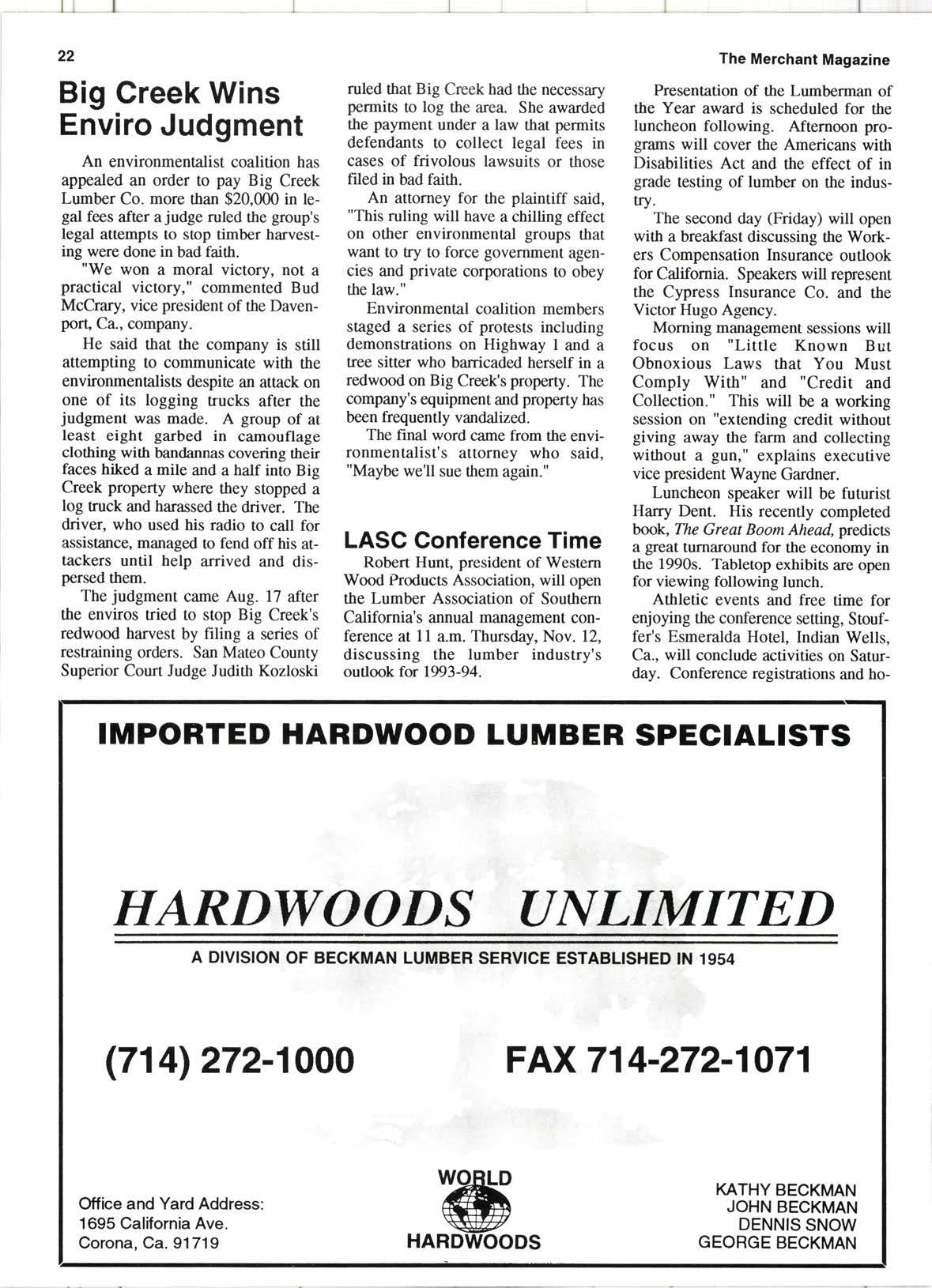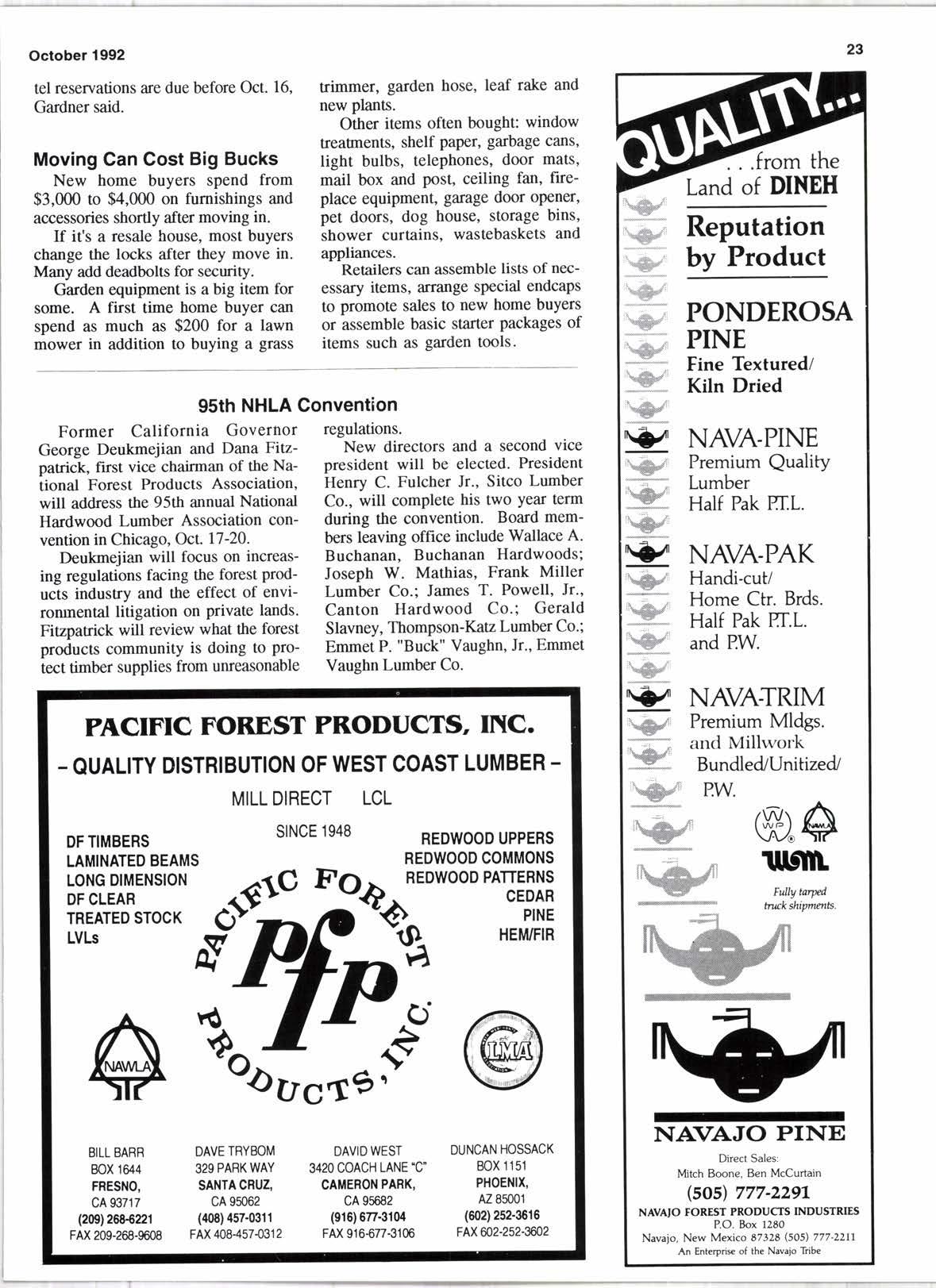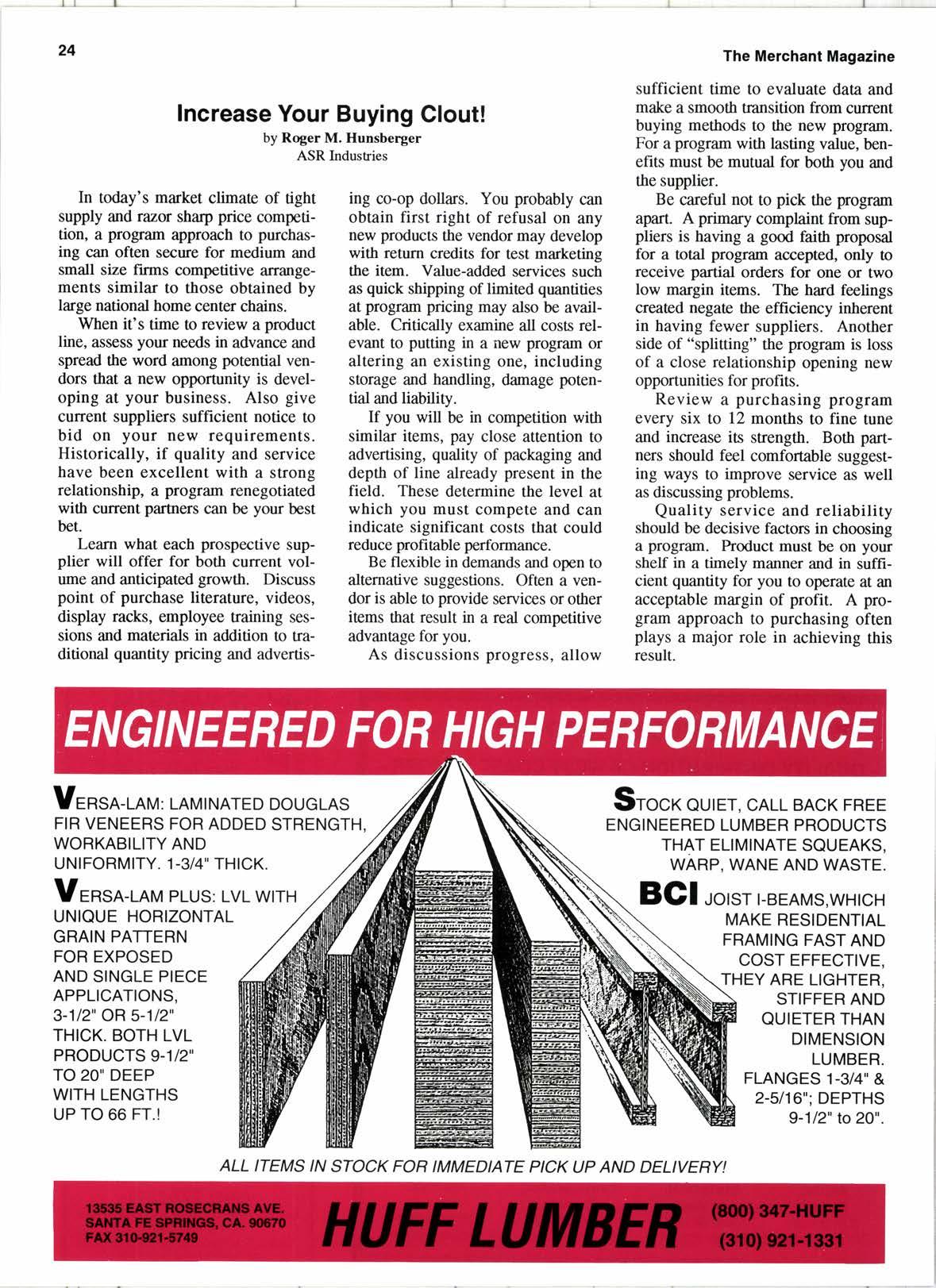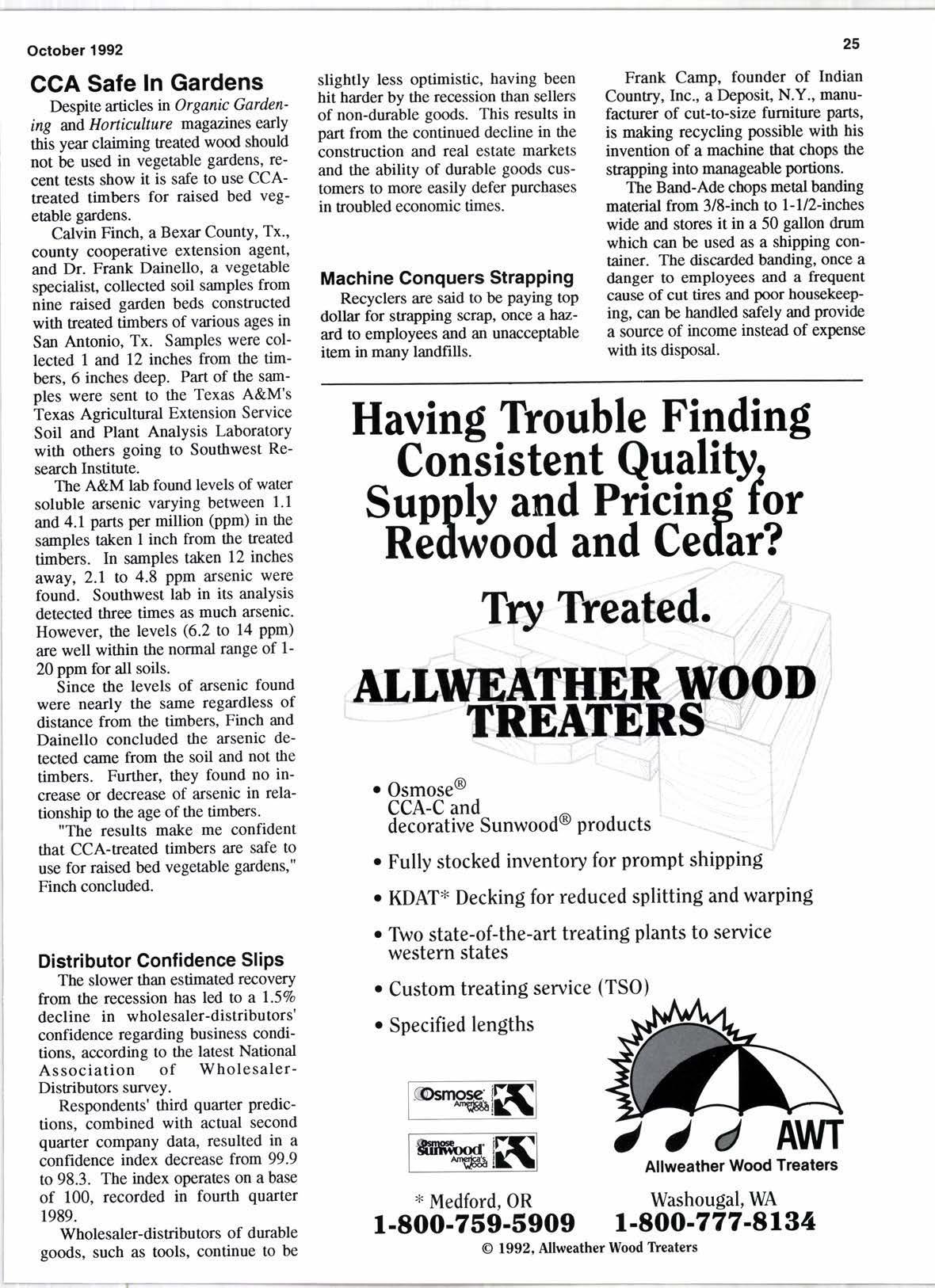
7 minute read
Big Creek Wins Enviro Judgment
An environmentalist coalition has appealed an order to pay Big Creek Lumber Co. more than $20,000 in legal fees after a judge ruled the group's legal attempts to stop timber harvesting were done in bad faith.
"We won a moral victory, not a practical victory," commented Bud McCrary, vice president of the Davenporl Ca., company.
He said that tle company is still attempting to communicate with the environmentalis6 despite an attack on one of its logging trucks after the judgment was made. A group of at least eight garbed in camouflage clothing with bandannas covering their faces hiked a mile and a half into Big Creek property where they stopped a log ruck and harassed the driver. The driver, who used his radio to call for assistance, managed to fend off his attackers until help arrived and dispersed them.
The judgment came Aug. 17 after the enviros tried to stop Big Creek's redwood harvest by filing a series of restraining orders. San Mateo County Superior Court Judge Judith Kozloski ruled that Big Creek had the necessary pennits to log the area. She awarded the payment under a law that pennits defendants to collect legal fees in cases of frivolous lawsuits or those filed in bad taith.
An attorney for the plaintiff said, "This ruling will have a chilling effect on other environmental groups tlat want to try to force govemment agencies and private corporations to obey the law."
Environmental coalition members staged a series of protests including demonstrations on Highway I and a tree sitter who barricaded herself in a redwood on Big Creek's property. The company's equipment and property has been frequently vandalized.
The final word came from the environmentalist's attorney who said, "Maybe we'll sue them again."
LASC Conference Time
Robert Hunt, president of Western Wood Products Association, will open the Lumber Association of Sou&ern California's annual management conference at 11 a.m. Thursday, Nov. 12, discussing the lumber industry's outlook for 1993-94.
The Merchant Magazine
Presentation of the Lumberman of the Year award is scheduled for the luncheon following. Afternoon programs will cover the Americans with Disabilities Act and the effect of in grade testing of lumber on the industry.
The second day (Friday) will open with a breakfast discussing the Workers Compensation Insurance outlook for California. Speaken will represent the Cypress Insurance Co. and the Victor Hugo Agency.
Morning management sessions will focus on "Little Known But Obnoxious Laws that You Must Comply With" and "Credit and Collection." This will be a working session on "extending credit without giving away the farm and collecting without a gun," explains executive vice president Wayne Gardner.
Luncheon speaker will be futurist Harry Dent. His recently completed fuk, The Gre at B oom Ahead, prdicts a great turnaround for the economy in the 1990s. Tabletop exhibits are open for viewing following lunch.
Athletic events and free time for enjoyrng the conference setting, Stouffer's Esmeralda Hotel, Indian Wells, Ca., will conclude activities on Saturday. Conference registrations and ho-
October 1992 tel reservations are due before Oct. 16, Gardner said.
Moving Can Cost Big Bucks
New home buyers spend from $3,000 to $4,000 on furnishings and accessories shortly after moving in.
If it's a resale house, most buyers change the locks after they move in. Many add deadbolts for security. Garden equipment is a big item for some. A first time home buyer can spend as much as $200 for a lawn mower in addition to buying a grass trimmer, garden hose, leaf rake and new plants.
Other items often boughu window trealnents, shelf paper, garbage cans, light bulbs, telephones, door mats, mail box and post, ceiling fan, freplace equipment, garage door opener, pet doors, dog house, storage bins, shower curtains, wastebaskets and appliances.
Retailers can assemble lists of necessary items, arrange special endcaps to promote sales to new home buYers or assemble basic starter packages of items such as garden tools.
95th NHLA Gonvention
Former California Governor
George Deukmejian and Dana Fitzpatrick, first vice chairman of the National Forest Products Association, will address the 95th annual National Hardwood Lurnber Association convention in Chicago, OcL U-20.
Deukmejian will focus on increasing regulations facing the forest products indusry and the effect of environmental litigation on private lands. Fitzpatrick will review what the forest products community is doing to protect timber supplies from urneasonable regulations.
New directors and a second vice president will be elected. President Henry C. Fulcher Jr., Sitco Lumber Co., will complete his two Year term during the convention. Board members leaving office include Wallace A. Buchanan. Buchanan Hardwoods; Joseph W. Mathias, Frank Miller Lumber Co.; James T. Powell, Jr., Canton Hardwood Co.; Gerald Slavney, Thompson-Katz Lumber Co.; Emmet P. "Buck" Vaughn, Jr., Emmet Vaughn Lumber Co.

lncrease Your Buying Clout!
by Roger M. Hunsberger ASR Indushies
In today's market climate of tight supply and razor sharp price competition, a prognm approach to purchasing can often secure for medium and small size fimrs competitive arrangements similar to those obtained by large national home center chains.
When it's time to review a product line, assess your needs in advance and spread the word among potential vendors that a new opportunity is developing at your business. Also give current suppliers sufficient notice to bid on your new requirements. Historically, if quality and service have been excellent with a strong relationship, a progran renegotiated with current partners can be your best bet.

Learn what each prospective supplier will offer for both current volume and anticipated growth. Discuss point of purchase literature, videos, display racks, employee training sessions and materials in addition to traditional quantity pricing and advertis- ing co-op dollars. You probably can obtain first right of refusal on any new produc8 the vendor may develop with return credits for test marketing the item. Value-added services such as quick shipping of limited quantities at program pricing may also be available. Critically examine all costs relevant to putting in a new progran or altering an existing one, including slorage and handling, damage potential and liability.
If you will be in competition with similar items, pay close attention to advertising, quality of packaging and depth of line already present in the field. These determine the level at which you must compete and can indicate significant costs that could reduce profitable performance.
Be flexible in demands and open to alternative suggestions. Often a vendor is able to provide services or other items that result in a real competitive advantage for you.
As discussions progress, allow
The Merchant Magazine sufficient time to evaluate data and make a smooth transition ftom current buying methods to the new program. For a program with lasting value, benefits must be mutual for both you and the supplier.
Be careful not to pick the prograrr apaft. A prinury complaint from suppliers is having a good faith proposal for a total program accepted, only to receive paftial orders for one or two low margin items. The hard feelings created negate the efficiency inherent in having fewer suppliers. Anotler side of "splitting" the program is loss of a close relationship opening new opportunities for profits.
Review a purchasing program every six to 12 months to fine tune and increase its strength. Both partners should feel comfortable suggesting ways to improve service as well as discussing problems.
Quality service and reliability should be decisive factors in choosing a progfilm. Product must be on your shelf in a timely manner and in sufficient quantity for you to operate at im acceptable margin of profit. A program approach to purchasing often plays a major role in achieving this result.
Vensn-r-nM: LAMTNATED DoucLAS FIR VENEERS FOR ADDED STRENGTH. WORKABILITY AND UNIFORMITY . 1 -314' THICK.
Ve*so-tAM PLUS: LVL wrrH
UNIQUE HORIZONTAL GRAIN PATTERN FOR EXPOSED AND SINGLE PIECE APPLICATIONS, 3-112',OR5-112', THICK. BOTH LVL PRODUCTS 9.112" TO 20" DEEP WITH LENGTHS UP TO 66 FT.!
BCI Jorsr r-BEAMS.wHrcH MAKE RESIDENTIAI FRAMING FAST AND COST EFFECTIVE, THEY ARE LIGHTER. STIFFER AND QUIETER THAN DIMENSION LUMBER. FLANGES 1-314'& 2-5|16": DEPTHS 9-112'to 20".
CCA Safe In Gardens
Desprte articles n Organic Garden' ing md Horticulture magazines early this year claiming reated wood should not be used in vegetable gardens, recent tests show it is safe to use CCAtreated tinbers for raised bed vegetable gardens.

Calvin Finch, a Bexar CountY, Tx., county cooperative extension agent, and Dr. Frank Dainello, a vegetable specialist, collected soil samples from nine raised garden beds constructed with treated timbers of various ages in San Antonio, Tx. SamPles were collected I md 12 inches from the timbers, 6 inches deep. Part of the samples were sent to the Texas A&M's Texas Agricultural Extension Service Soil and Plant Analysis Laboratory with others going to Southwest Research Instiurte.
The A&M lab found levels of water soluble arsenic varying between 1.1 and 4.1 parts per million (ppm) in the samples taken I inch from the Eeated timbers. In samples taken 12 inches away, 2.1 to 4.8 PPm arsenic were found. Southwest lab in its analysis detected three times as much arsenic. However, the levels (6.2 to 14 PPm) are well within the normal range of 120 ppm for all soils.
Since the levels of arsenic found were nearly the same regardless of distance from the timbers, Finch and Dainello concluded the arsenic detected came from the soil and not the timbers. Further, theY found no increase or decrease of arsenic in relationship to the age of the timbers.
"The results make me confident that CCA-treated timbers are safe to use for raised bed vegetable gardens," Finch concluded.
Distri butor Confidence Slips
The slower than estimated recovery from the recession has led to a 1.5Vo decline in wholesaler-distributors' confidence regarding business conditions, according to the latest National Association of WholesalerDistributors survey.
Respondents' third quarter predictions, combined with actual second quarter company data, resulted in a confidence index decrease from 99.9 to 98.3. The index operates on a base of 100, recorded in fourth quarter r989.
Wholesaler-distributors of durable goods, such as tools, continue to be slightly less optimistic, having been hit harder by the recession than sellers of non-durable goods. This results in part from the continued decline in the construction and real estate markets and the ability of durable goods customers to more easily defer purchases in noubled economic times.
Machine Conquers StraPPing
Recyclers are said to be Paying top dollar for strapping scrap, once a hazard to employees and an unacceptable item in many landfills.
Frank Camp, founder of Indian Country, Inc., a Deposit, N.Y., manufacturer of cut-to-size furniture parts, is making recycling possible with his invention of a machine that chops the srdpping into manageable portions.
The Band-Ade chops netal banding material ftom 3/8-inch to l-l/2-inches wide and stores it in a 50 gallon drum which can be used as a shipPing container. The discarded banding, once a danger to employees and a frequent cause of cut tires and poor housekeeping, can be handled safely and provide a source of income instead of expense with its disposal.










